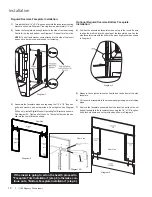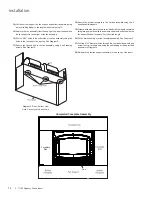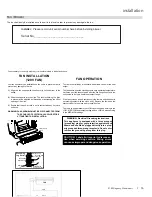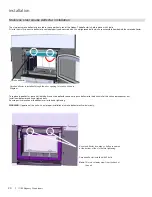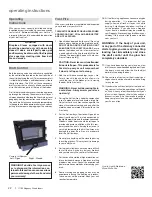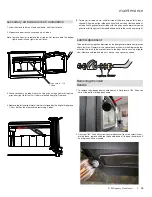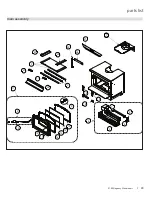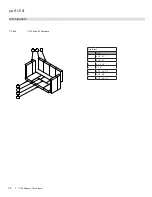
24
|
I1150 Regency Wood Insert
maintenance
Creosote
When wood is burned slowly, it produces tar and
other organic vapours combine with moisture to
form creosote. The creosote vapours condense in
the relatively cool chimney flue of a slow burning
fire. As a result, creosote residue accumulates on
the flue lining. When ignited, this creosote can
result in an extremely hot fire.
The chimney connector and chimney should be
inspected at least once every two months during
the heating season to determine if creosote build
up has occurred. If creosote has accumulated it
should be removed to reduce the risk of chimney fire.
CAUTION: Things to remember in case of
a chimney fire:
1. Close all draft controls.
2. CALL THE FIRE DEPARTMENT.
Ways to Prevent and Keep Unit Free
of Creosote
1. Burn stove with the draft control wide open
for about 10-15 minutes every morning during
burning season.
2. Burn stove with draft control wide open for about
10 - 15 minutes every time you apply fresh wood.
This allows the wood to achieve the charcoal
stage faster and burns up any unburned gas
vapours which might otherwise be deposited
within the system.
3. Only burn seasoned wood! Avoid burning kiln
dried, wet or green wood. Seasoned wood has
been dried at least one year.
Wood Storage
Store wood under cover, such as in a shed, or cov-
ered with a tarp, plastic, tar paper, sheets of scrap
plywood, etc., as uncovered wood can absorb water
from rain or snow, delaying the seasoning process.
Maintenance
It is very important to carefully maintain your fire-
place stove, including burning seasoned wood and
maintaining a clean stove and chimney system. Have
the chimney cleaned before the burning season
and as necessary during the season, as creosote
deposits may build up rapidly. Moving parts of your
stove require no lubrication.
4. A small hot fire is preferable to a large smoul-
dering one that can deposit creosote within the
system.
5. The chimney and chimney connector should be
inspected at least once every two months during
the heating season to determine is a creosote
buildup has occurred.
6.
Have chimney system and unit cleaned by
competent chimney sweeps twice a year
during the first year of use and at least once
a year thereafter or when a significant layer
of creosote has accumulated (3 mm / 1/8" or
more) it should be removed to reduce the
risk of a chimney fire.
Door Gasket
If the door gasket requires replacement 5/8" diameter
material must be used. Regency uses a gasket rope
7/8" (Part #846-570). A proper high temperature
gasket adhesive is required. See your Regency
Dealer.
The door catch may require adjustment as the door
gasket compresses after a few fires. The door latch
compression may require adjustment to renew seal.
Removal of a shim, (see section in this manual),
will allow the latch to be moved closer to the door
frame, causing a tighter seal.
Glass Maintenance
Your Regency stove is supplied with 5mm Neoceram
ceramic glass (Part #846-306) that will withstand the
highest heat that your unit will produce. In the event
that you break your glass by impact, purchase your
replacement from an authorized Regency dealer
only, and follow our step-by-step instructions for
replacement (refer to Glass Replacement section).
Allow the stove to cool down before cleaning
the glass. Cleaning the glass will prevent build
up of carbon and allow full view of the fire.
WARNING:
Do not clean the glass when it is hot.
WARNING:
Do not use abrasive cleaners, a damp
cloth and glass cleaner is effective.
Summary of Contents for Cascades I1150
Page 36: ...36 I1150 Regency Wood Insert ...
Page 37: ...I1150 Regency Wood Insert 37 notes ...
Page 38: ...38 I1150 Regency Wood Insert notes ...
Page 39: ...I1150 Regency Wood Insert 39 ...



